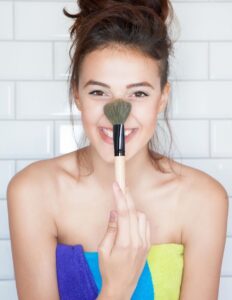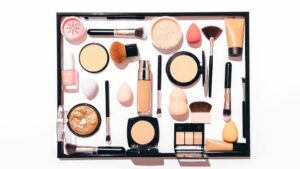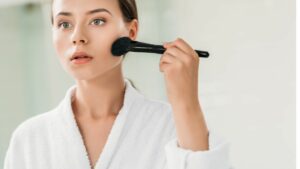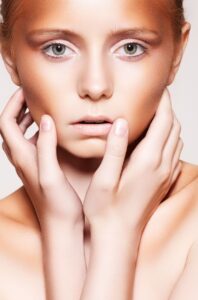Fool-proof: Bronzer for Every Skin Type
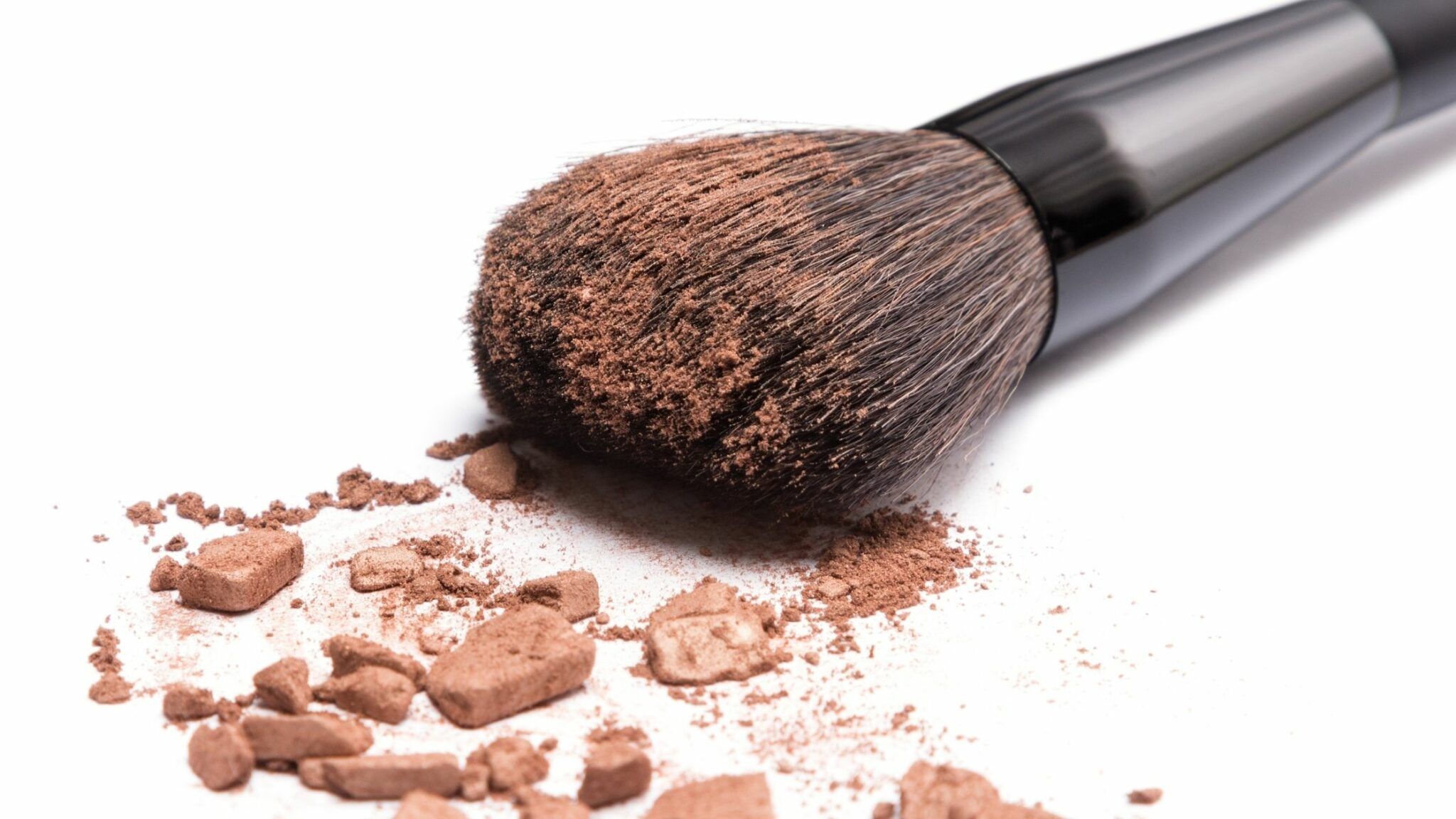
It was 1984 when Guerlain launched the first pressed tanning powder. Terracotta (Italian: burnt earth) was its name, and some woman who wore it often looked exactly like it. At that time, the powder was spread generously over the entire face. This often had the effect of tinting your skin faster than you would like, as if you wanted to perform at the Winnetou Festival. But a lot has happened in the meantime. The war path number has become a contouring and freshening miracle.
When the bronzer is applied to the right places on the face, it gives the exact glow that the US make-up artist Mark Carrasquillo describes as if you had just been on a hike in the Himalayas. In any case, the winter pallor disappears, contours are accentuated. With every stroke of the brush, the complexion actually takes on the outrageously fresh radiance of mountain air.
The hair color sets the tone
But with bronzer you just have to be careful and careful. If you use it incorrectly, the tan immediately looks unnatural and overdone. Almost everything depends firstly on the right tone and secondly on the application technique. The color shade usually depends on the skin type. If you misjudge it, the experiment can go wrong again. The easiest way to orientate yourself is by your hair color. It goes without saying that it is natural and not the current color.
Bronzer for Blondes
In terms of the world’s population, less than two percent are real blondies. Around the globe, around 98 percent have dark to black hair, and less than one percent have red hair. The natural complexion of blonde women often shows a slight yellow tinge. For the tanning powder, it is therefore advisable to choose a lighter shade with pink pigments. In the case of extremely light skin, the bronzer is only – and really only – applied to the cheeks, thinly with an extra-large brush, as otherwise the face will quickly appear covered with make-up. Everyone else can add a touch of color to the forehead and bridge of the nose for contour effects.
Bronzer for black hair
A brown natural hair color in all shades allows a little more color. It often tends to have a slight reddish cast. For the bronzer this means: You can choose a warmer shade that contains orange pigments. For a rather cool brown, light brown nuances with a subtle gold cast are recommended. As a general rule, brunettes can use a little more tint on their cheeks. So feel free to brush your cheekbones with your brush more often. Make sure to let the tan run out gently and without hard edges. This is the only way to get the natural touch. Remain cautious on the forehead and bridge of the nose and apply a single layer of powder.
Bronzer for black haired people
The darker the brown or black of the hair, the stronger the bronzer tone can be. Gold-colored pigments are used to soften an olive-tinged complexion. The lighter the skin, the better the light terracotta colors harmonize. For a natural result, apply the powder where – as the saying goes – the sun kisses the skin. So forehead, cheeks and chin. If you have enlarged pores or oily skin, regardless of the hair color, it is best to avoid any shimmer. That just emphasizes the whole dilemma unnecessarily. You avoid this with matte nuances.
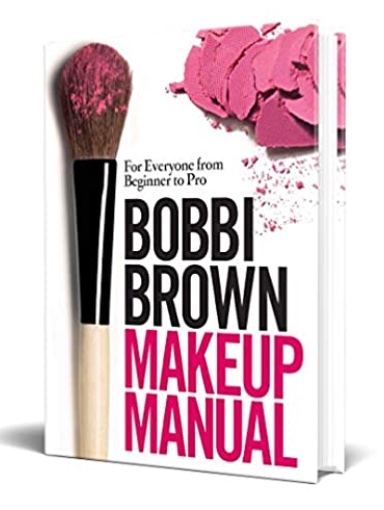
She is a make up icon
Who coul explain make up better than Bobbi Brown. In her “Makeup Manual: For Everyone from Beginner to Pro“* you find everything what you want to know about about make-up and the science of skin. Also with never-before-seen tips on blush, bronzer, lip liners, lipstick and more. Book, 232 pages, 21,99 Euro
Bronzer for redheads
For the complexion of redheads, bronzer can provide a golden sunkissed glow all year round. If you have very light skin, as most of them have, you should choose a tanning powder that is close to your natural skin tone. A shimmering peach shade with a touch of pink, for example. As is often advised, never choose a shade that is two shades darker. This punishes the complexion with an unsightly tinge of orange, making it look dirty and artificial. Here, too, bronzer is applied to the areas that the sun would tan the most.
Make up the bronzer properly
If you are inexperienced or impatient with make-up, it is best to use bronzer in powder form. The easiest way to spread these is with a thick fluffy brush. For cream or liquid textures, use a flat, wide foundation brush or a damp sponge. This means that the bronzer is spread more opaque, but also more evenly. A cream product only works better for very dry skin because powder makes it even drier. In general, fingers are not a good tool because the result is usually blotchy.
The skin is prepared as usual with foundation, a primer or just a moisturizer, if it is even enough. So that you don’t end up with an overdose of bronzer on your face right from the start, don’t dip the brush deeply into the loose powder or rub wildly over the middle of a compact. It is better to roll the sides of the brush over the bronzer. This guarantees a more even distribution on the hair. Then tap off the brush and off you go.
Start at the sides of the forehead, always leaving the center blank. Then pull the bronzer in a C-shape with gentle, loose movements on the cheeks, and continue to the chin. If necessary, blend in the transitions. If there is only a little product left on the brush, you can gently stroke it over the bridge of your nose, chin and neck. If you don’t find the tan intense enough, you can easily rework. Building up in layers is usually much easier than removing too much. And always remember: The top priority for bronzers is: less is more!
*This is an affiliated link. You don’t pay more. It is just a little thank you for our team!

CultureAndCream Author from Munich
To travel during my profession as a beauty journalist was never enough for my. Also my six month on a world trip didn’t do it. It always attracts me to other cities, foreign countries, on roadtrips and places I don’t know yet. But I am not only interested in “culture” and “cream”, I am also fascinated by people who have stories to tell . Such unique experiences I want to share with you.
